Three Million Miles and 1,140 Tons
Miles to where and tons of what?
Hyundai announced recently that its 2017 Tucson FCEV (Fuel Cell Electric Vehicle) reached some pretty lofty numbers. Since being introduced in 2014, 150+ Tucson FCEV have been delivered to customers and have driven in excess of three million miles. In the process, they have only emitted clean water from the tailpipe, which has replaced more than 1,140 tons of CO2 emissions compared to the same number of miles driven in a conventional gasoline-powered vehicle.
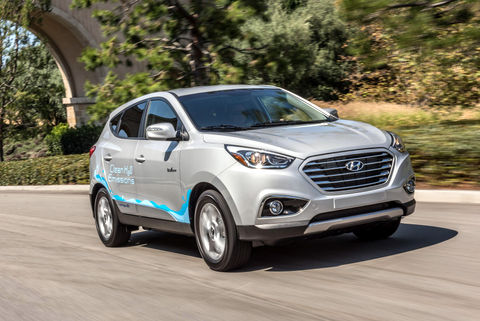
Sounds great, and it is, but with a few caveats. First off, you need to live in California to be part of Hyundai’s hydrogen program. You then need to prove you live near one of the state’s 33 hydrogen fueling stations. Then you have the opportunity to lease (not buy) a Hyundai Tucson FCEV. Why all the restrictions, because heck, isn’t hydrogen the most abundant element on Earth? Yes, it is, but with a few more caveats.
Converting hydrogen from its natural state into a fuel is an expensive process. Oil companies have not jumped onboard with any semblance of enthusiasm to produce hydrogen as a transportation fuel in mass quantity, nor investing in building retail hydrogen fuel stations, which cost about $1.2 million dollars each. From the oil company’s standpoint, why should they go to the expense when there are so few hydrogen-powered cars on the road (only 2,298 were sold/leased in 2017)? Hyundai, Honda and Toyota (the three auto manufacturers that currently build and market consumer hydrogen vehicles) respond that, how can we get more cars on the road with so few stations? And sales in 2017 did double from the previous year. A true conundrum for our times.
So while these companies are trying to figure which came first – the chicken or the egg, let’s take a look at the merits of the Hyundai Tucson FCEV, one of the three fuel cell vehicles on the market, and see if having more stations will get you into one.
Hydrogen Power: On the Road
The 2017 Hyundai Tucson FCEV Clean Fleet Report tested for a few days had a 95 kW AC synchronous motor producing 134 horsepower and 221 pounds-feet of torque. The Environmental Protection Agency estimates the fuel economy to be 50 mi/kg (miles per kilogram of hydrogen) for combined city and highway, with an estimated 265-mile driving range. About that driving range–don’t test it unless you know for a FACT you will be near a hydrogen fueling station when the tank is getting low. Because, if you run out of fuel, your next call will be for emergency roadside assistance and a ride home on a flatbed. Something else about when it is time to refuel: make sure to do it before the tank is empty as there is a detailed process to get the hydrogen system operating again, which can only be performed by a factory-trained technician.

Out on the road, the Tucson was stable and unaffected by Southern California’s grooved concrete freeways. The grooving is for rain dispersion so tire noise in any car is common, and the seams between the concrete sections can, if hit at the right sped, produce a rhythmic thumpity-thumpity-thump. The Tucson, with 17-inch alloy wheels, 215/60R tires and electronic stability control, delivered handling that was direct with little body roll, even though it’s an upright crossover design. There is nothing sporty about the Tucson but, then again, Hyundai does not market it as a sporty car. Excessive wind noise was not an issue, making the silent electric motor even that more enjoyable.
The Tucson’s battery is replenished through the regenerative braking charging system. This technology converts kinetic energy into electric energy and stores it in the battery when applying the brakes or coasting. This process can be viewed on a dash gauge where you can watch the power flow into and out of the battery and electric motor. The regenerative brakes made solid stops with a system consisting of power assisted discs, anti-lock brakes (ABS), brake assist and electronic brake-force distribution.
Hydrogen Fueling
After your first visit to a hydrogen fuel station, you will be a pro. Start by going to The California Fuel Cell Partnership website to find stations that are on your driving route. Since there are so few, you will come to memorize their locations quickly. Stations are open 24/7 and unattended, but there is a toll-free number to call for assistance. A drawback is that the stations are not always operational, so it is imperative to check the website often.

Once at the station, the fueling process is explained through a video that plays on the pump and a sign with step-by-step instructions. Quick lesson: The nozzle notches into the car, followed by the twisting of a handle to lock it in place. It can be a bit tricky. Be patient, it will eventually fit. If there are two pressure options on your pump, you always want to select 70 Bar, which is 10,000 psi. The filling will start and stop for a few seconds at a time, but a complete fill is under five minutes. When removing the nozzle, you will notice it is cold. This is because the hydrogen gas is cooled to right around zero degrees Fahrenheit to increase the hydrogen’s density, which results in more gas filling the tank. That’s it! Take your receipt for your free fill-up (more on that free gas later) and off you go.
Free? Yes, free! Since Hyundai will only lease the Tucson FCEV, they include the hydrogen fuel in the lease.
Crossover Interior Benefits
The 2017 Tucson can seat five full-size adults, with the rear passengers getting good head and leg room, a 60/40 split rear seat and a center armrest with cup holders. The front and rear leather covered seats are heated. The driver’s front seat is power adjustable, with lumbar support. Comfort-wise, the seats are firm and, for the driver, finding a good driving position is helped by the power tilt and telescopic steering column.
Gauges are large and well-placed for viewing. The largest element of the dash is an seven-inch high-resolution touch-screen color display, housing the navigation and rear view camera. The 360-watt, with subwoofer, infotainment system was AM/FM/SiriusXM/HD Radio equipped, along with CD and MP3 capability. There is also Bluetooth streaming, iPod and auxiliary audio jacks and an USB port, all controlled hands-free by the controls on the leather-wrapped steering wheel. The audio system has knobs for volume and channel selection, something Clean Fleet Report requires for a sound system to get an A+ grade from our discerning staff.
Pricing
The 2017 Tucson FCEV comes in one model, with no options other than exterior color. All Tucson FCEVs are leased, which is what you want to do with any battery electric or fuel cell car as the technology is changing so rapidly that ownership is not the way to go. The current lease offer is $2,999 at signing and $499 per month, for 36 months. Remember that all your fuel is included and, in California, fuel cell cars qualify for the coveted HOV lane sticker that allows a single driver to use the carpool lane.
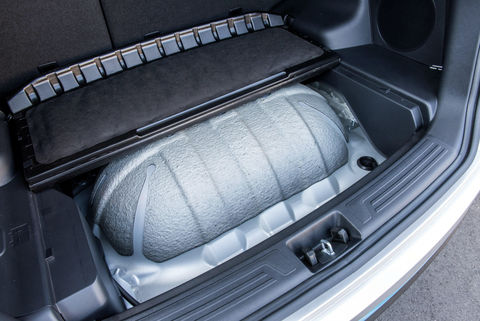
Safety, Convenience and Warranties
The 2017 Hyundai FCEV has not been rated by the National Highway Traffic Safety Administration or the Insurance Institute for Highway Safety. However, it is well equipped for safety with front and side-impact airbags with rollover sensors and the carbon-fiber hydrogen fuel tank is virtually bulletproof. The gasoline version of the Tucson received a 5 Star (top) rating from the National Highway Traffic Safety Administration.
Convenience features include remote keyless entry, push button start/stop, power door locks and windows, dual automatic climate control with clean air ionizer, auto-dimming inside rearview mirror with Homelink and compass, heated and power outside mirrors and a tire pressure monitoring system.
The 2017 Tucson FCEV comes with these warranties:
- Powertrain 10 years/100,000-miles
- New Vehicle Five years/60,000 miles
- Roadside Assistance Five years/Unlimited miles
- Anti-perforation Seven years/Unlimited miles
Observations: 2017 Hyundai Hydrogen Fuel Cell
Hydrogen is listed first on the periodic table. Good being first, but there is a reason as hydrogen has a near unlimited abundance. Capturing it and separating it into hydrogen gas is an expensive proposition.

Hydrogen currently sells for around $10 per equivalent to a gallon of gasoline. To run a FCEV versus a plug-in electric will cost about four times as much, varying based on your cost of electricity. To sweeten the deal, Hyundai includes all the fuel over a three-year lease, so you do not need to be concerned with the price of hydrogen gas. Just fill ‘er up and go!
Is the Tucson FCEV right for your lifestyle and driving pattern? If you are looking for a car with the most useable interior space among all fuel cell vehicles, the Tucson is it. The crossover has an excellent reliability record and will cost nothing to operate, so it may be a good option. Of course, the real deciding factor is where you live. If you are reading this outside of California, you will have to wait awhile before hydrogen fuel cell technology comes to your state.
What’s Next from Hyundai
Late in 2018, as a 2019 model, Hyundai is releasing an all-new hydrogen fuel cell vehicle. Announced at the 2018 Consumer Electronics Show (CES), the Hyundai Nexo is a striking, small SUV that continues Hyundai’s exclusivity of offering a fuel cell vehicle in the most popular vehicle category. Since the Honda Clarity and Toyota Mirai are sedans, Hyundai has placed themselves in a strong position to gain buyers, especially as the hydrogen fuel stations increase in number.
Whatever you end up buying, enjoy your new car and as always, Happy Driving!
Related Stories You Might Enjoy:
News: 2019 Hyundai Nexo FCEV Introduced
Road Test: 2017 Toyota Mirai (Steve’s view)
Road Test: 2017 Toyota Mirai (John’s view)
News: Honda Clarity Family Named Green Car of the Year
First Drive: Honda Clarity Fuel Cell
News: 2014 LA Auto Show: A Hydrogen Milestone



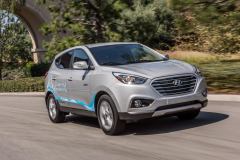

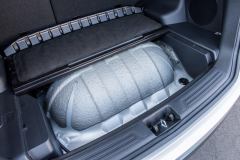
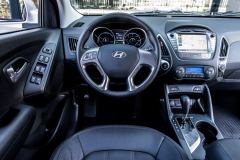
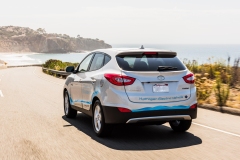
9 thoughts on “Road Test: 2017 Hyundai Tucson Hydrogen Fuel Cell”